Lessons from FDA 483s and cGMP Inspection Data
Production and process controls, organization and personnel were the top problems found, while packaging and labelling citations increased in 2017 and 2018.
Ivan Traimak - stock.adobe.com

To provide insight into regulatory trends and factors contributing to noncompliance, the authors analyzed data from Form 483 observations issued by FDA during routine investigations of finished drug and API manufacturing sites between 2014 and 2018. The goal was to provide pharmaceutical quality compliance professionals, managers, and operators with insights into how they can best strengthen compliance and develop appropriate solutions for key regulatory compliance issues. This article summarizes results of the study.
To review the basics, form 483s are issued by FDA’s Office of Regulatory Affairs (ORA), which is responsible for field activities such as site inspections and enforcement (1). ORA inspectors issue Form 483 observations when they find current good manufacturing practice (cGMP) violations during a facility inspection. These observations are then presented to the company’s senior managers to notify them of the need to correct compliance deficiencies.
Inspection observations are crucial, because they define the site’s state of compliance. Companies that receive 483s are expected to ensure that steps are taken to correct problems and address the observations and any auxiliary systems that are also deficient but not cited. The final establishment inspection report (EIR) then determines the resulting regulatory actions, considering the observations, proposed corrective measures, and evidence collected.
Three different types of observation classifications (2) are possible:
- No Action Indicated (NAI) indicates that no objectionable conditions were found during inspection and that no further regulatory action required.
- Voluntary Action Indicated (VAI) shows that objectionable conditions were found, but the agency is not yet willing to take any regulatory action.
- Official Action Indicated (OAI) shows that ORA will recommend specific actions.
This study used data from FDA’s Inspection Classification Database, which was established in 2009 as part of a transparency initiative (3). The analysis used data classified as final, which is updated by FDA and posted on the agency’s website each month. Any undisclosed inspections are not captured in the list. The inspectional observation data set files for years 2014, 2015, 2016, 2017, and 2018 provided the full list of audit observations. For instance, the 2014 list of inspectional observations included inspections that ended between Oct. 1, 2013 and Sept. 30, 2014.
FDA recorded a total of 2997 audit observations in 2014, including 645 Form 483s issued for finished formulation and API sites, which, in turn, were classified into nine categories (4):
- Subpart B, organization and personnel
- Subpart C, buildings and facilities
- Subpart D, equipment
- Subpart E, control of components and drug product containers and closures
- Subpart F, production and process controls
- Subpart G, packaging and labeling control
- Subpart H, holding and distribution
- Subpart I, laboratory controls
- Subpart J, records and reports.
The inspection classification database detailed the number of official and voluntary actions (OAIs and VAIs), whether at US manufacturing sites or at sites outside of the United States.
The authors used the Pearson correlation coefficient to identify any positive correlation between the variables, where positive correlation indicates that as the values of one variable increase the values of the other variable increase (5).
Results and discussion
Between 2014 and 2018, the total number of FDA Form 483 audit observations was found to range from 2997 to 3626, with an average of 3362 observations per year. The agency issued a total of 3424 Form 483s, an average of 685 per year. However, 716 483s were issued in 2018, a higher number than seen in previous years (Figure 1 and Table I).
Figure 1: Final classified form 483 observations, final drug product and API. Figures are courtesy of the authors.
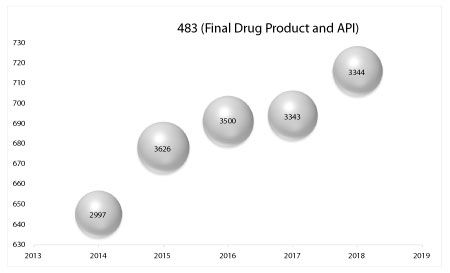
Table I: 483 observations final drug product and API 2014–2018.
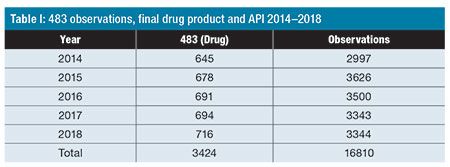
Figure 2 and Table II summarize the nine categories of inspection observations and associated subsections.
Figure 2: Number of observations by good manufacturing practice (GMP) subsections.
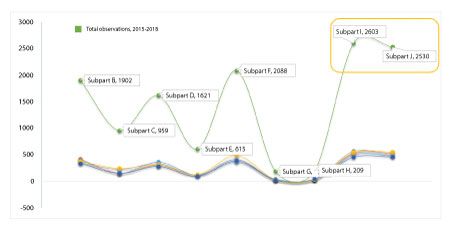
CLICK IMAGE TO ENLARGE Table II: 483 observations, final drug product and API 2014-2018.

The data provide a clear indication that most 483 observations were related to Subpart I–laboratory controls, which accounted for 2603 observations, and Subpart J–records and reports, with 2530 observations. The other top contributors were Subpart F–production and process controls (with 2088 observations), Subpart B–organization and personnel (with 1902 observations), and Subpart D–equipment (with 1621 observations).
Figure 3 illustrates the percentage changes in the identified observation categories. The most relevant fluctuations would be the increase in FDA observations for packaging and labeling control (Subpart G) in 2017 and 2018. Also noteworthy is the spike in equipment (Subpart D) observations, which went from 311 to 370 between 2017 and 2018. However, laboratory control observations decreased during the same period, which may reflect the implementation of improved system and data integrity laboratory controls.
VAI and OAI trends
Figure 3: Change of observation types, year over year (in percentages).
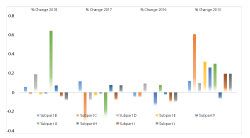
VAI and OAI are critical for companies, because they indicate non-compliance and the need for critical actions, which may have implications for product quality and supply. Data showed that there has been a consistent reduction in the issuance of VAI and OAI since 2017, suggesting a higher rate of compliance with regulatory guidance requirements, as found during inspections.
The finished formulation and API site inspection trend (Figure 4) indicates a declining domestic inspections trend; however, there was no corresponding increase in foreign site inspections, which may reflect the fact that FDA has adopted a risk-based inspection management process. The data were also analyzed to determine whether there were any correlations between the variables: number of VAI/OAI, number of domestic inspections, and number of foreign inspections.
Figure 4: Voluntary Action Indicated (VAI), Official Action Indicated (OAI) and domestic, foreign inspections of finished formulation and API sites.
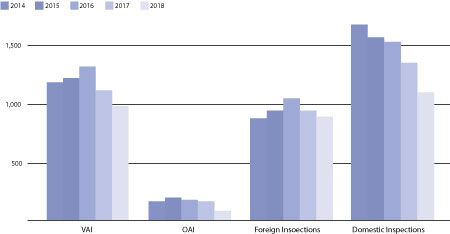
Based on the Pearson correlation coefficient calculation of X values (domestic inspections) and Y values (number of VAI/OAI), the value of R is 0.9443, suggesting a strong positive correlation between X and Y variables. The p-value is 0.015648, hence statistically significant (<0.05). The correlation was not seen when VAI/OAI numbers were compared with foreign inspection trend. It can be, therefore, concluded that there is a higher tendency to generate VAI/OAI observations if the domestic inspection rate increases.
Figure 5a: Pearson correlation coefficient.

The Pearson Correlation Coefficient for individual GMP observations associated with the nine subparts (B through J) were analyzed for 2014 through 2018 (Figure 5a and b). A positive correlation could be ascertained across laboratory control observations (Subpart I) and records and reports (Subpart J). This may suggest that increased regulatory scrutiny of laboratory controls may have resulted in improved good documentation practices, because there appeared to be an improvement in records and reports observations as well. A summary of statistics is found in Figure 6.
Figure 5b: Result details and calculation.

CLICK IMAGE TO ENLARGE Figure 6: Summary statistics.
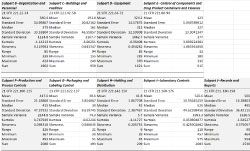
Although additional analysis might be required to confirm the correlation, it is safe to assume that laboratory data integrity-based inspection assessment extends from GMP sections Subpart J to Subpart I. As an inspection readiness strategy, organizations should provide equal weight to laboratory electronic controls, procedures, specifications, and methods as well as to data access and integrity (6), and to the storage of raw data and reports, whether electronic or paper.
Conclusion
Analysis of FDA Form 483 observations issued from 2014 to 2018 revealed that the number of 483 forms issued has increased during this time period, while the number of observations has declined. The number of VAI and OAI observations issued has also fallen since 2017.
Over this period, there has been a decrease in domestic inspections, and a positive correlation was found between the number of domestic inspections conducted and the number of VAI/OAI observations issued. The highest number of observations were related to Subpart I–laboratory controls and Subpart J–records and reports, Subpart F–production and process controls, Subpart B–organization and personnel, and Subpart D–equipment.
Increased inspection of laboratory controls (Subpart I) may also result in increased good document practices, records and reports observations (Subpart J) based on the positive correlation observed. It is also noteworthy that there was an increase in packaging and labeling control (Subpart G) observations in 2018.
Note: This article was prepared by the authors in their personal capacities. The opinions expressed are the authors’ own and do not reflect the view of their employer, government, or any agency with which they are affiliated.
References
1. M. Hamburg, Justification of Estimates for Appropriations Committees Fiscal Year 2016, US Department of Health and Human Sciences, FDA (2015).
2. FDA, Integration of FDA Facility Evaluation and Inspection Program for Human Drugs: A Concept of Operations (June 6, 2017).
3. FDA, Transparency Initiative: Draft Proposals for Public Comment to Increase Transparency by Promoting Greater Access to the Agency’s Compliance and Enforcement, FDA Data Transparency Task Force, US Department of Health and Human Services (2011).
4. Code of Federal Regulations, Title 21: Part 210, 211: Food and Drugs, Current Good Manufacturing Practices.
5. J. Freeman, T. Young, Correlation Coefficient: Association Between Two Continuous Variables, Scope Tutorial, (2009).
6. D. Hodgson, F. Maini, et al., Under the Spotlight: Data Integrity in Life Sciences, (Deloitte, London, UK 2017).
About the Authors
Ajay Pazhayattil is a management consultant (ajpazha@gmail.com). Marzena Ingram is senior manager, quality and compliance at Eurofins CDMO. Naheed Sayeed is deputy director, validation services at Sanofi.
Article Details
Pharmaceutical Technology
Vol. 43, No. 10
October 2019
Pages: 56–61
Citation
When referring to this article, please cite it as A. B. Pazhayattil, M. Ingram, and N. Sayeed, “Lessons from FDA 483s and cGMP Inspection Data,” Pharmaceutical Technology 43 (10) 2019.
